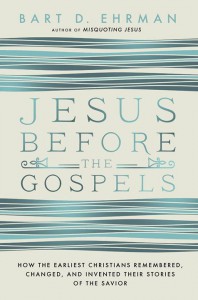Book Review: Jesus before the Gospels by Bart Ehrman

Having now written a dozen books, University of North Carolina Religious Studies Professor Bart Ehrman has long been a mainstay in the research and exploration of early Christian history. He has used those tools of historical and literary research to read and analyze the earliest church writings with clarity and fairmindedness. He is, quite frankly, one of my favorite authors.
His new book, Jesus before the Gospels: How the Earliest Christians Remembered, Changed, and Invented Their Stories of the Savior, adds to his impressive body of research and analysis but explores a new line of historical inquiry, to wit: How reliable are the oral traditions that formed the basis of the New Testament writings before they were even written down?
His answer depends on what you mean by “reliable.” If you mean how historically accurate they are in the details of Jesus’s life, death, and teachings, then that answer is probably “not very.” But if you’re asking how useful are they in tracing the early beliefs, needs, and travails of the Christian Church, then they are a mine of information.
Ehrman outlines the problem he explores:
The disciples were lower-class, illiterate peasants who spoke Aramaic, Jesus’ own language. The Gospels, on the other hand, were written by highly educated Greek-speaking Christians forty to sixty-five years later. . . .Ultimately most of the stories they [the Gospel authors] told must have come from oral traditions, as followers of Jesus told and retold stories about him—starting while he was alive and then even more after he was dead. These oral traditions were in circulation year after year, and decade after decade, before they were inherited by the authors of our Gospels.
He then takes on the many problems this timeline raises, bringing to bear the most recent research on both memory and transmission of oral histories.
One problem he tackles is the idea of eyewitness testimony itself. In the last twenty years, much research has been done on the reliability of such testimony, and, quite frankly, the results aren’t good. Even fresh eyewitness testimony is subject to much error, and within only a few weeks, much disinformation and distortion has (often unintentionally) slipped into even the most reliable accounts.
Other problems lie in the transmission of this testimony from one person to another. Christianity in its early years was both oral and evangelistic. The stories weren’t told and retold with an eye to keeping them exact, but to illuminating the teachings and lessons of Jesus Christ. Layered on top of this was a continual renewal of the stories to reflect how they were germane to the events of the times, such as the destruction of the Temple in Jerusalem and the expansion of Christianity outside of Israel into Rome and beyond.
It is in this last layer that the real meat of Ehrman’s analysis of early Christian history comes through most fully. He explores the stories as recorded—their differences, the known history from other sources—and teases out the reasons why those differences appeared. He places it solidly in the context of history and the needs of the early Christian church (and thereby, without directly saying so, debunks the argument that this is holy scripture, untouched by human bias).
Ehrman’s writing is always clear, concise, and very readable, and this book is no different. However, by necessity, a lot of this book deals not so much with the history itself, but with the science and research studies that form its basis. It provides an exploration of the framework in which the Bible, once written down, must be approached. This background science, while interesting on its own and necessary to his thesis, may seem to be a bit beside the point to those looking more to the story of how it affects our understanding of early Christianity. For people who have not read Ehrman before, I would recommend starting instead with some of his other books, such as Jesus, Interrupted: Revealing the Hidden Contradictions in the Bible or Misquoting Jesus: The Story behind Who Changed the Bible and Why. In a way, this book is built on those, and the reader should start there. Just be sure to eventually make your way back here.
